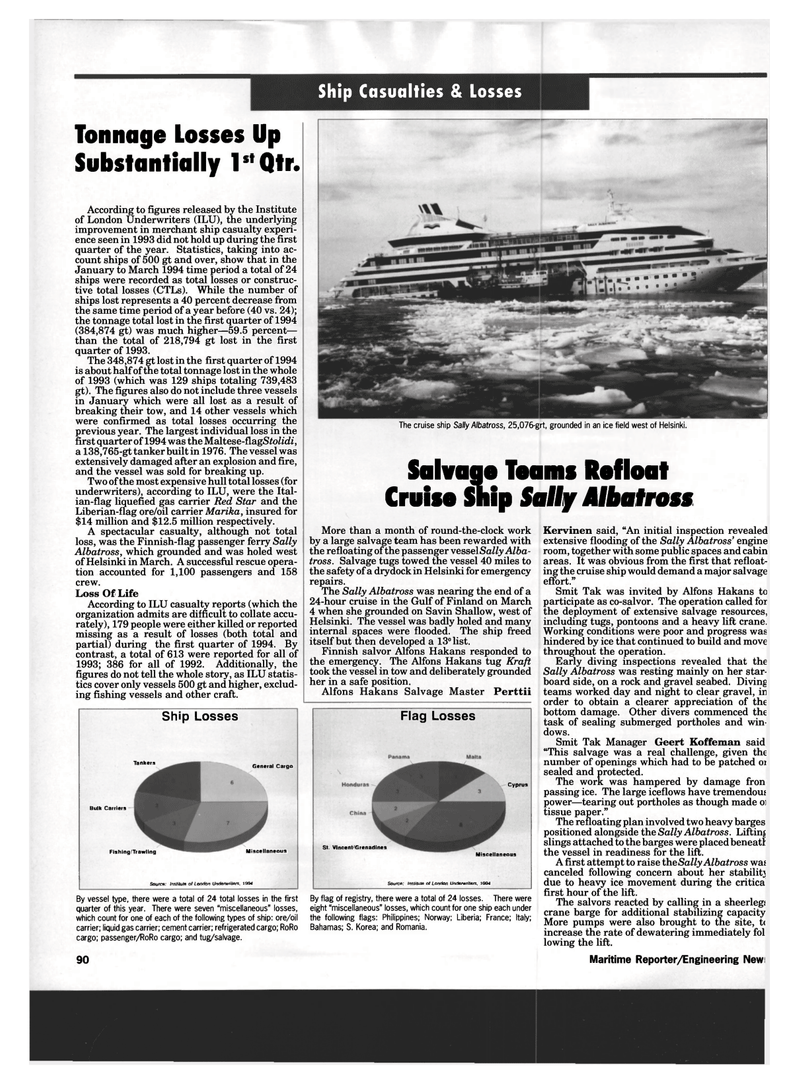
Page 80: of Maritime Reporter Magazine (June 1994)
Read this page in Pdf, Flash or Html5 edition of June 1994 Maritime Reporter Magazine
Ship Casualties & Losses
Tonnage Losses Up
Substantially 1st Qtr.
According to figures released by the Institute of London Underwriters (ILU), the underlying improvement in merchant ship casualty experi- ence seen in 1993 did not hold up during the first quarter of the year. Statistics, taking into ac- count ships of 500 gt and over, show that in the
January to March 1994 time period a total of 24 ships were recorded as total losses or construc- tive total losses (CTLs). While the number of ships lost represents a 40 percent decrease from the same time period of a year before (40 vs. 24); the tonnage total lost in the first quarter of 1994 (384,874 gt) was much higher—59.5 percent— than the total of 218,794 gt lost in the first quarter of 1993.
The 348,874 gt lost in the first quarter of 1994 is about half of the total tonnage lost in the whole of 1993 (which was 129 ships totaling 739,483 gt). The figures also do not include three vessels in January which were all lost as a result of breaking their tow, and 14 other vessels which were confirmed as total losses occurring the previous year. The largest individual loss in the first quarter of1994 was the Maltese-flagSfoZidi, a 138,765-gt tanker built in 1976. The vessel was extensively damaged after an explosion and fire, and the vessel was sold for breaking up.
Two of the most expensive hull total losses (for underwriters), according to ILU, were the Ital- ian-flag liquefied gas carrier Red Star and the
Liberian-flag ore/oil carrier Marika, insured for $14 million and $12.5 million respectively.
A spectacular casualty, although not total loss, was the Finnish-flag passenger ferry Sally
Albatross, which grounded and was holed west of Helsinki in March. A successful rescue opera- tion accounted for 1,100 passengers and 158 crew.
Loss Of Life
According to ILU casualty reports (which the organization admits are difficult to collate accu- rately), 179 people were either killed or reported missing as a result of losses (both total and partial) during the first quarter of 1994. By contrast, a total of 613 were reported for all of 1993; 386 for all of 1992. Additionally, the figures do not tell the whole story, as ILU statis- tics cover only vessels 500 gt and higher, exclud- ing fishing vessels and other craft.
By vessel type, there were a total of 24 total losses in the first quarter of this year. There were seven "miscellaneous" losses, which count for one of each of the following types of ship: ore/oil carrier; liquid gas carrier; cement carrier; refrigerated cargo; RoRo cargo; passenger/RoRo cargo; and tug/salvage. 90
The cruise ship Sally Albatross, 25,076-grt, grounded in an ice field west of Helsinki.
Salvage Teams Refloat
Cruise Ship Sally Albatross
More than a month of round-the-clock work by a large salvage team has been rewarded with the refloating of the passenger ve sselSally Alba- tross. Salvage tugs towed the vessel 40 miles to the safety of a drydock in Helsinki for emergency repairs.
The Sally Albatross was nearing the end of a 24-hour cruise in the Gulf of Finland on March 4 when she grounded on Savin Shallow, west of
Helsinki. The vessel was badly holed and many internal spaces were flooded. The ship freed itself but then developed a 13° list.
Finnish salvor Alfons Hakans responded to the emergency. The Alfons Hakans tug Kraft took the vessel in tow and deliberately grounded her in a safe position.
Alfons Hakans Salvage Master Perttii
By flag of registry, there were a total of 24 losses. There were eight "miscellaneous" losses, which count for one ship each under the following flags: Philippines; Norway; Liberia; France; Italy;
Bahamas; S. Korea; and Romania.
Kervinen said, "An initial inspection revealed extensive flooding of the Sally Albatross' engine room, together with some public spaces and cabin areas. It was obvious from the first that refloat- ing the cruise ship would demand a major salvage effort."
Smit Tak was invited by Alfons Hakans to participate as co-salvor. The operation called for the deployment of extensive salvage resources, including tugs, pontoons and a heavy lift crane.
Working conditions were poor and progress was hindered by ice that continued to build and move throughout the operation.
Early diving inspections revealed that the
Sally Albatross was resting mainly on her star- board side, on a rock and gravel seabed. Diving teams worked day and night to clear gravel, in order to obtain a clearer appreciation of the bottom damage. Other divers commenced the task of sealing submerged portholes and win- dows.
Smit Tak Manager Geert Koffeman said "This salvage was a real challenge, given the number of openings which had to be patched oi sealed and protected.
The work was hampered by damage fron passing ice. The large iceflows have tremendous power—tearing out portholes as though made oi tissue paper."
The refloating plan involved two heavy barges positioned alongside the Sally Albatross. Lifting slings attached to the barges were placed beneatf the vessel in readiness for the lift.
A first attempt to raise the Sally Albatross was canceled following concern about her stability due to heavy ice movement during the critica first hour of the lift.
The salvors reacted by calling in a sheerlegs crane barge for additional stabilizing capacity
More pumps were also brought to the site, t< increase the rate of dewatering immediately fol lowing the lift.
Maritime Reporter/Engineering News
Ship Losses
Bulk Carriers
Source: Institute ol London Underwriters. 1994
Tankers General Cargo
Fishing/Trawling Miscellaneous
Flag Losses
St. Vincent/Grenadines
Cyprus
Miscellaneous
Source: Institute of London Underwriters, 1994

 79
79

 81
81
